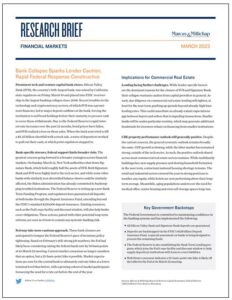Bank Collapse Sparks Lender Caution, Rapid Federal Response Constructive
Prominent tech and venture capital bank closes. Silicon Valley Bank (SVB), the country’s 16th-largest bank, was seized by California state regulators on Friday, March 10 and placed into FDIC receivership in the largest banking collapse since 2008. Recent troubles in the technology and cryptocurrency sectors, of which SVB was a prominent financier, led to major deposit outflows at the bank, forcing the institution to sell bond holdings before their maturity to procure cash to cover these withdrawals. Due to the Federal Reserve’s rapid interest rate increases over the past 12 months, bond prices have fallen, and SVB realized a loss on those sales. When the bank next tried to fill a $2.25 billion shortfall with a stock sale, a wave of depositors worked to pull out their cash, at which point regulators stepped in.
Bank-specific stresses, federal support limits broader risks. The greatest concern going forward is a broader contagion across financial markets. On Sunday, March 12, New York authorities shut down Signature Bank, which held roughly half the assets of SVB. Both Signature Bank and SVB were highly tied to the tech sector, and while some other banks with similarly non-diversified balance sheets could be similarly affected, the Biden administration has already committed to backstopping troubled institutions. The Federal Reserve is setting up a new Bank Term Funding Program, and regulators have guaranteed all deposits at both banks through the Deposit Insurance Fund, extending beyond the FDIC’s standard $250,000 deposit insurance. Existing resources, such as the Fed’s repo facility and discount window, will also help banks cover obligations. These actions, paired with other potential long-term reforms, are seen as of now to contain any systemic banking risk.
Fed may take more cautious approach. These bank closures are anticipated to temper the Federal Reserve’s pace of monetary policy tightening. Based on February’s still-strong job numbers, the Fed had likely been considering raising the federal funds rate by 50 basis points at its March 22 meeting. Current market consensus no longer considers that an option, but a 25-basis-point hike is possible. Market expectations are now for the central bank to ultimately end rate hikes at a lower terminal level than before, with a growing cohort of market participants foreseeing the need for a rate cut before the end of the year…DOWNLOAD FULL RESEARCH BRIEF.
Sources: Marcus & Millichap Research Services; Capital Economics; Federal Reserve; CME FedWatch Tool; Reuters; Bloomberg



